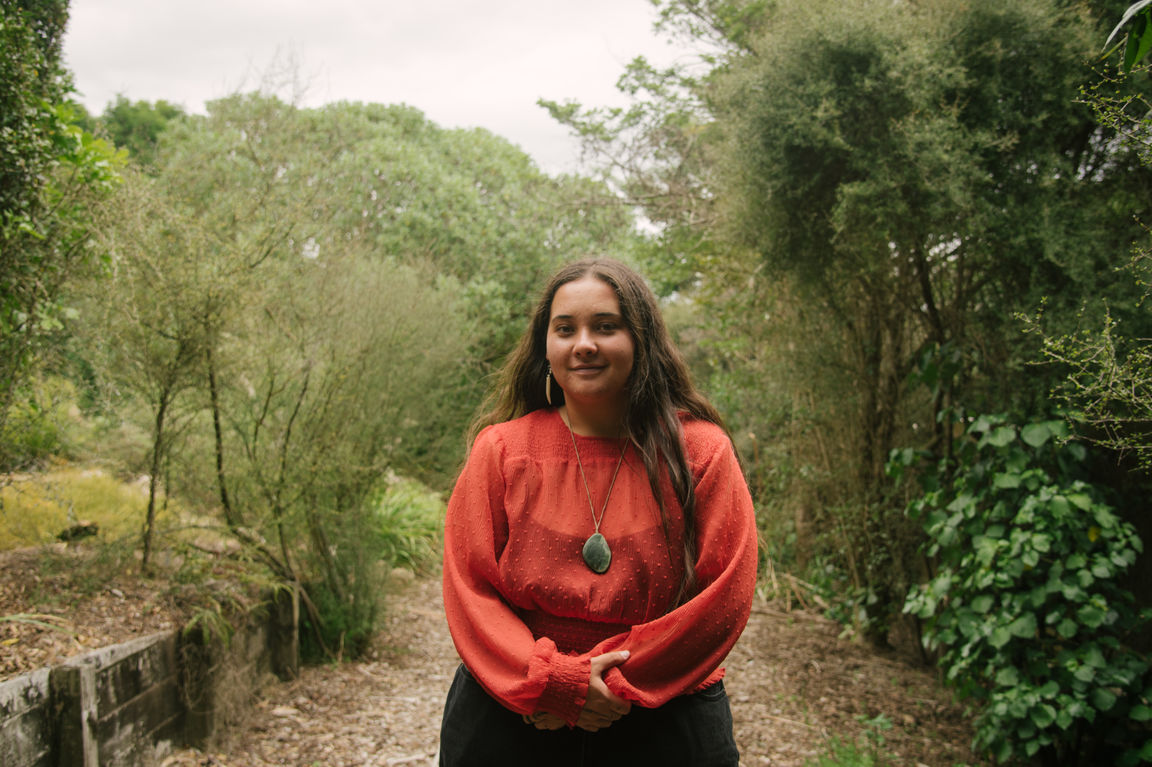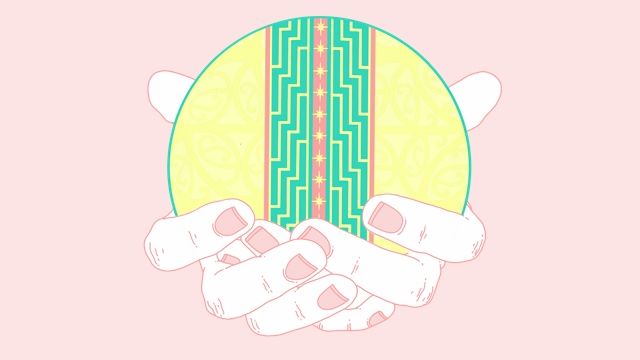In the fourth episode of He Kākano Ahau: Wawatatia, spoken in te reo, we ask how we might uphold Māori traditions for the wellbeing of the people and the environment. We learn about traditional kai harvest practices as Mere Skerrett prepares for the imminent tītī harvest season in Murihiku Southland.
Scroll down the bottom of the article to listen to the podcast.

Mere Skerrett and Melody Thomas on top of Motupōhue / Bluff Hill Photo: UGP / Kahu Kutia
Mahinga Kai
by Kahu Kutia
English translation is below te reo Māori text.

At Murihiku Marae in Waihōpai Photo: UGP / Kahu Kutia
Kia wawatatia e tātou te pae tawhiti. Kia tuituia e tātou he ao e ū ana ki te manaakitanga, ki te aroha, ki te kotahitanga. Ka mua, ka muri, ki te ao whai oranga. Ko He Kākano Ahau: Wawatatia te kaupapa e whai ake nei.
Kia hoki tātou ki ngā tikanga ā ngā tīpuna; kia whakatipungia e tātou he kai nā te māra, kia whaia e tātou te maramataka. Kia tika ngā mahi i te wao. Kia hono atu ki te whenua, ki te wai hei oranga mā tātou katoa. Ko te motuhaketanga o te kai tētahi kaupapa ka kaha rangona i ngā hapū me ngā iwi puta noa i te motu.
E whai ana tēnei wāhanga o He Kākano Ahau i te pātai, ka pēhea te mahinga kai e poipoi i te ahurea Māori? Ka tae atu a Kahu Kutia ki Waihōpai te kōrero atu ki a Mere Skerrett, tōna kaiako i a ia i te kōhanga reo. Kei te whakarite a Mere ki te rapu tītī. Kua ngahuru te whenua i te tonga o Te Waipounamu, ā, ka kōrerohia e Kahu rāua ko Mere ngā kōrero tuku iho e pā ana ki te mahinga kai.

Mere shows a video from the tītī harvest Photo: UGP / Kahu Kutia
"He mīharo ngā manu tītī. Ka taea te ruku kaimoana kia rapu kai. Nō reira ko ngā tītī, koira te take o te whakataukī "Kia manawa tītī". Kia pērā i te tītī, kia tino kaha ki te whai atu i tōu e hiahia ana."
Ka tū te wāhanga rapu tītī mai i te 1 o Paengawhāwhā, tae atu ki te 31 o Haratua. Ko tēnei te wā e taea ana e ngā whānau o tēnei rohe te haere atu ki ngā moutere ki te rapu, ki te nanao i ēnei manu. I ngā wā o mua, ka tukuna ngā manu ki te pōhā, he pēke ka hangaia ki te rimurapa, ki te harakeke, ki te tōtara anō hoki. Inaianei, ka tukuna ki te pākete kē. Mai i ngā pākete ka tukuna ki ngā whānau puta noa i te motu e hiakai ana ki tēnei kai rangatira.
Ko tā Mere, e hāngai ana te reo rapu tītī ki te tirohanga taketaketake o tōna iwi. Ko Mere tētahi e whakapau kaha ana ki ngā mahi whakarauora reo, ā, ka tino ū ōna whakaaro ki te whakarauora reo i roto i ngā mahinga kai.
"Kei te kite atu kei te mimiti haere koira te take e hiahia ana te tae atu, haere atu ki ngā moutere whakawhitiwhiti kōrero i roto i te reo, he mea nui tērā ki te whakaora anō. Tēra rautaki te whakarauora reo, he rautaki whai whakarauora tangata. He rite me te taiao, he rautaki whakarauora taiao."

Michael Skerrett Snr and his partner Photo: UGP / Kahu Kutia
Ka tūtaki tātou ki te matua kēkē o Mere, ki a Michael Skerrett Snr. Kua roa tēnei kaumātua e aro ana ki te mahinga kai. Ka kōrero ia mō te huringa āhuarangi, me ngā rerekētanga o te mahinga kai i ēnei rā.
"Traditionally, one year in seven the birds would be skinny - kihaka - but last season was the first decent season we've had since 2007. Thirteen years. So it's a real, real worry."
Ka pērā hoki ngā whakaaro o Mere. E āwangawanga ana ia ki te oranga o tēnei manu kei anamata, me te oranga o ngā tikanga me te reo Māori.
"Ae rā, ki te ngaro te reo ka ngarongaro, ka mimiti haere ngā tikanga, he raruraru nui tēnā. Ki te ngaro te reo ka ngaro ngā tikanga Māori, kaore e kore ka raru ko te whenua me ngā manu."
E aro ana tēnei hōtaka ki te ao kei tua, me te pātai, ka pēhea tātou e hāpai i ā tātou taonga tuku iho mō te oranga o te iwi me te taiao.
A return to the ways of our tūpuna; food harvested from the garden and in line with a traditional maramataka. Sustainable hunting practices. Connection to water and land maintained through a symbiotic relationship in which all are fed. Self-sovereign food practices like these are something often discussed amongst our hapū and iwi.
This episode of He Kākano Ahau asks how we might connect traditional food gathering practices to culture and identity.
Kahu Kutia heads to Waihōpai to catch up with her kōhanga reo teacher Mere Skerrett, who is preparing for a trip to the tītī islands for the annual muttonbirding season.

At Murihiku Marae in Waihōpai Photo: UGP / Kahu Kutia
In the cold autumn landscape of the deep South, Kahu and Mere journey through some of the history of mahinga kai.
As Kahu finds out, there is more to the practice than simply seeking sustenance.
"He mīharo ngā manu tītī. Ka taea te ruku kaimoana kia rapu kai. Nō reira ko ngā tītī, koira te take o te whakataukī "Kia manawa tītī". Kia pērā i te tītī, kia tino kaha ki te whai atu i tōu e hiahia ana."
The tītī season happens around April 1 to May 31 every year.
During this time, those with a valid permit and whakapapa to the islands are permitted to travel and catch tītī. While traditionally stored in pōhā - bags made from bull kelp, harakeke and tōtara bark, today the salty birds are stored in buckets and shipped round the country to whānau eagerly awaiting their share of this prized delicacy.
For Mere, there is a connection between the language used to harvest the birds and a cultural perspective unique to Ngāi Tahu and Ngāti Māmoe.
As one of many people working hard to revitalise te reo Māori, Mere Skerrett is particularly interested in the link between mahinga kai practices and te reo.
"Kei te kite atu kei te mimiti haere koira te take e hiahia ana te tae atu, haere atu ki ngā moutere whakawhitiwhiti kōrero i roto i te reo, he mea nui tērā ki te whakaora anō. Tēra rautaki te whakarauora reo, he rautaki whai whakarauora tangata. He rite me te taiao, he rautaki whakarauora taiao."
In this episode, we also meet Mere's uncle, Michael Skerrett Snr. Michael has spent decades observing the changes in the practice and had many thoughts to share on the impact of climate change on the tītī harvest.
"Traditionally, one year in seven the birds would be skinny - kihaka - but last season was the first decent season we've had since 2007. Thirteen years. So it's a real, real worry."
It's a sentiment echoed by Mere, with her focus not only on the survival of tītī populations into the future but also how that impacts tikanga and te reo Māori.
"Ae rā, ki te ngaro te reo ka ngarongaro, ka mimiti haere ngā tikanga, he raruraru nui tēnā. Ki te ngaro te reo ka ngaro ngā tikanga Māori, kaore e kore ka raru ko te whenua me ngā manu."

At the bottom end of Te Waipounamu Photo: UGP / Kahu Kutia
About He Kākano Ahau:

Kahu Kutia Photo: UGP / Dylan Cook
After co-winning Best Episodic/Recurrent Podcast at the 2020 Voyager Media Awards, activist, writer and uri of Ngai Tūhoe, Kahu Kutia returns with season two. She leads a close-knit team across the motu in search of stories woven together by whakapapa and desire to be and exist bigger and better.
This season’s creative team also includes producer and editor, Melody Thomas, of the award-winning sex and sexuality podcast BANG!, journalist, producer and editor Frances Morton continues with He Kākano Ahau alongside producer and award-winning filmmaker Ursula Williams as the podcast’s executive producers. Te Hira Mayall-Nahi (Ngāti Whatua ki Kaipara, Te Rarawa) and Briar Pomana (Ngāti Kahungunu, Ngāti Rakaipaaka), came on board in teina roles to assist with production.

He Kākano Ahau: Wawatatia is a seven-episode series, including two episodes in te reo Māori. Our target audience is young Māori, but we hope the stories make space for everyone to listen in.
